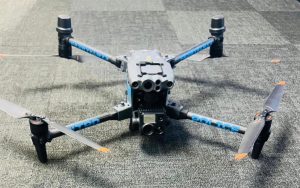Beyond the Last Mile: Zipline’s Eco-Friendly Urban Delivery Solution
By Richard Thomas
Drone delivery is poised to revolutionize the logistics sector, significantly cutting down emissions and eliminating excessive packaging. Zipline’s Platform 2 combines all-electric drones with streamlined delivery paths, presenting a sustainable alternative to traditional last-mile delivery methods.

Current urban last-mile delivery systems generate large volumes of carbon emissions and packaging waste. Research from the World Economic Forum indicates that emissions from last-mile delivery in major cities could increase by over 30%, causing traffic congestion and delaying daily commutes by 11 minutes. Back in 2019, global e-commerce used around 2.1 billion pounds of plastic packaging, a figure that is set to double to an estimated 4.5 billion by 2025.
Zipline’s all-electric Zip UAS are designed to be zero-emission aircraft. The P2 Zip integrates an automated delivery droid with a drone that streamlines the process, removing unnecessary packaging for deliveries weighing up to 5 pounds. The company claims that each Zipline flight cuts carbon emissions by an impressive 97% when compared to traditional gas-powered vehicles. Their drones are equipped with detect and avoid (DAA) technology, which allows for safe operations without visual observers—a critical development for the future of drone deliveries, especially in an era where reducing emissions is crucial.

Enhancing Delivery Efficiency
The P2 platform boasts up to seven times faster delivery times than conventional vehicles, capable of covering a 10-mile distance in approximately 10 minutes. As Zipline strives to expand commercial BVLOS operations into the Dallas metro area, we caught up with Jo Mardell, the head of engineering, to delve into the company’s sustainability efforts in urban drone delivery.
Key Sustainability Efforts
IUS: Can you elaborate on Zipline’s sustainability initiatives regarding emissions and logistical efficiencies?
MARDELL: Our approach is based on three pillars. First, our fully electric drones are highly efficient, achieving around 85% operational efficiency compared to gas engines at around 25%. This alignment with renewable energy sources as the grid evolves is significant.
Secondly, our aircraft take direct routes to delivery points, cutting emissions drastically—around 30 times less than gas vehicles and over 10 times less than electric ones. Their lightweight construction, just 1% of a car’s weight, allows for improved efficiency.
Lastly, our drones demand far fewer materials than regular vehicles. Where a car weighs between 3,000 and 5,000 pounds, our drones weigh between 50 and 60 pounds, minimizing emissions linked to manufacturing and logistics.
Logistics and Supply Chain Efficiency
IUS: How does Zipline’s compact vehicle design enhance logistics and supply chains compared to traditional fleets?
MARDELL: The benefits are clear. As the demand for parcel deliveries grows, the outdated methods used to transport goods can be inefficient. Our Platform 2 reimagines last-mile delivery by directly reaching delivery sites, avoiding the unnecessary emissions associated with traditional vehicle use.
Minimizing Packaging Waste
IUS: The reduction of packaging waste appears to be a central aspect of your service. Can you tell us more?
MARDELL: Exactly. Our delivery droid only requires the item placed in its payload bay—no extra packaging needed. This approach eliminates the frustrating amount of packaging waste typically found in recycling bins. We aim to streamline this experience for consumers.
Insights from BVLOS Operations
IUS: With recent BVLOS approval in North Texas, have you observed any efficiency improvements?
MARDELL: We are excited about the prospects of BVLOS deliveries, which we believe will significantly impact efficiency. With a 10-mile operational range, we can serve vast urban areas much more effectively than traditional short-distance car deliveries. Our platform recently saved over 900,000 gallons of gasoline from our delivery miles, a number that will exceed one million soon. We have conducted over 1.2 million deliveries, totaling nearly 90 million autonomous miles globally.
Energy Metrics
IUS: What are the energy requirements for each delivery?
MARDELL: Our drones are extremely energy-efficient, using about the same power as an electric car’s air conditioning. One delivery requires less than a kilowatt-hour of energy, far less than typical household energy consumption. We use less energy to deliver a package than what’s needed to boil water for cooking.
Long-Term Sustainability
IUS: What other critical factors contribute to a sustainable logistics operation at scale?
MARDELL: Longevity is crucial. Our drones can last as long as vehicles, boasting lifespans beyond 400,000 miles. The longevity of our aircraft showcases the environmental advantages of using lightweight drones over cars for last-mile deliveries.
Impact on Urban Air Quality
IUS: What advantages do drones have over traditional delivery vehicles concerning maintenance and environmental impact?
MARDELL: There’s a notable reduction in urban air pollutants since drones don’t produce harmful emissions. By decreasing the number of delivery vehicles in urban settings, we can restore public spaces corrupted by traffic, thereby enhancing air quality and minimizing health risks. It’s inspiring to work towards a future where urban areas are cleaner and more efficient, paving the way for a better living environment.
For more information, read the original article: Original Article.













